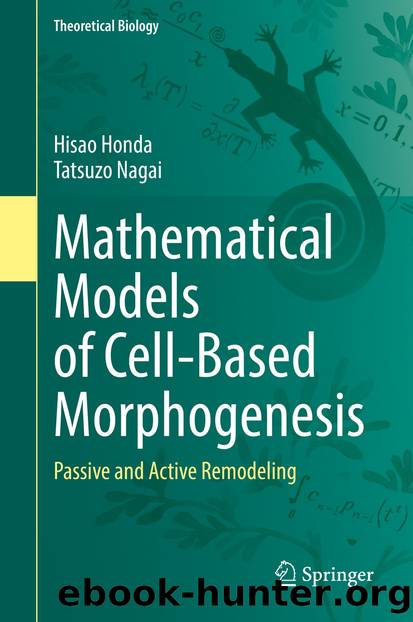Mathematical Models of Cell-Based Morphogenesis by Hisao Honda & Tatsuzo Nagai

Author:Hisao Honda & Tatsuzo Nagai
Language: eng
Format: epub
ISBN: 9789811929168
Publisher: Springer Nature Singapore
The calculation process to find a stable state is exemplified in Fig. 6.15. In this example, the aggregate is surrounded and restricted by an ellipsoidal (1.2:1) capsule (Honda et al. 2008), corresponding to an ellipsoidal ZP in vivo. A vertex (small solid circle in Fig. 6.15 at t = 0), replaced by a tetrahedron (see Fig. 6.14b), is enlarged until its volume reaches half the initial total volume (at t = 500; see Fig. 6.14c). The embryonicâabembryonic axis (Em-Ab axis) keeps changing with respect to the outer capsule until the embryonic pole, the position of the ICM, is localized at one end of the long axis of the ellipsoidal capsule (t = 2000). The structure is then âstabilized,â remaining unchanged thereafter for a substantial amount of time (t = 2000â3500), equivalent to the time required to stabilize the structure (t = 0â2000). Tracing of cells (Fig. 6.15, marked with * and +) further demonstrates that cells and the cavity gradually change their position relative to each other during the process. The cell with * migrates to a cluster of cells (t = 500). The cell with + is situated at the center of the cluster, and the cluster (including the cell labeled with +) migrates and stabilizes at one end of the long axis (t = 1000â3500). The enlarging cavity eventually becomes surrounded by an outer single-cell layer, with its position stabilized at one end of the long axis, while a cluster of cells forms on the opposite side (Fig. 6.16). Thus, the simulation recapitulates the blastocyst morphology in vivo well, with the outside cells corresponding to the TE and the inner population to the ICM.
Fig. 6.15An example of the calculation process to reach a stable state. Viewed from cross-sections of the yz-plane. Numbers indicate the time point of the simulation (t). A vertex (black circle in the sample at t = 0) is replaced by a tetrahedron (see Fig. 6.14b) and is enlarged until its volume reaches half the initial total volume (at t = 500; see Fig. 6.14c). The blastocyst axis continuously changes during t = 500â2000 until it is localized and stabilized at one end of the long axis of the ellipsoidal ZP (t = 2000), when it no longer migrates (t = 2000â3500). Two cells are marked (* and +) to illustrate their movement. To see this figure in color, go online (Honda et al. 2008) [Reproduced from Fig. 4A in Honda et al. 2008 with permission of The Company of Biologists]
Download
This site does not store any files on its server. We only index and link to content provided by other sites. Please contact the content providers to delete copyright contents if any and email us, we'll remove relevant links or contents immediately.
| Anatomy | Animals |
| Bacteriology | Biochemistry |
| Bioelectricity | Bioinformatics |
| Biology | Biophysics |
| Biotechnology | Botany |
| Ecology | Genetics |
| Paleontology | Plants |
| Taxonomic Classification | Zoology |
Sapiens: A Brief History of Humankind by Yuval Noah Harari(14321)
The Tidewater Tales by John Barth(12626)
Mastermind: How to Think Like Sherlock Holmes by Maria Konnikova(7279)
Do No Harm Stories of Life, Death and Brain Surgery by Henry Marsh(6906)
The Thirst by Nesbo Jo(6881)
Why We Sleep: Unlocking the Power of Sleep and Dreams by Matthew Walker(6657)
Life 3.0: Being Human in the Age of Artificial Intelligence by Tegmark Max(5516)
Sapiens by Yuval Noah Harari(5324)
The Longevity Diet by Valter Longo(5042)
The Body: A Guide for Occupants by Bill Bryson(5030)
The Rules Do Not Apply by Ariel Levy(4910)
The Immortal Life of Henrietta Lacks by Rebecca Skloot(4550)
Animal Frequency by Melissa Alvarez(4428)
Why We Sleep by Matthew Walker(4394)
The Hacking of the American Mind by Robert H. Lustig(4339)
Yoga Anatomy by Kaminoff Leslie(4333)
All Creatures Great and Small by James Herriot(4271)
Double Down (Diary of a Wimpy Kid Book 11) by Jeff Kinney(4242)
Embedded Programming with Modern C++ Cookbook by Igor Viarheichyk(4141)
